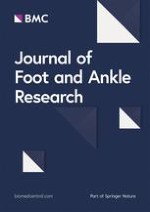Background
Materials and methods
Results and discussion
p-value | HF–TB dorsiflexion | HF–T B int. rotation | HF–TB inversion | FF–TB dorsiflexion | FF–TB adduction | FF–TB supination | FF–HF dorsiflexion | FF– HF adduction | FF–HF supination |
|---|---|---|---|---|---|---|---|---|---|
NN & NF
| 0.999 | 0.581 |
*0.000
| 0.856 | 0.462 |
*0.013
| 0.529 | 0.069 | 0.118 |
NN & SF
| 0.999 | 0.719 |
*0.000
| 0.998 |
*0.000
|
*0.001
| 0.346 |
*0.000
|
*0.004
|
NF & SF
| 0.997 | 0.999 |
*0.004
| 0.944 |
*0.000
| 0.271 | 0.822 |
*0.000
| 0.171 |
